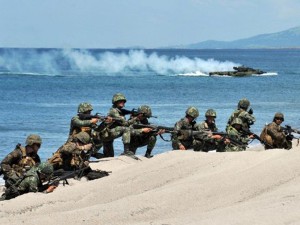The Yanks are coming back

US and Philippine Marines simulate an amphibious landing as part of RP-US Amphibious Landing Exercise on a beach in San Antonio, Zambales on October 23, 2011. AFP
The United States plans to send 4,500 Marines currently stationed in Japan to Guam and to rotate an additional 4,000 troops “through Australia, Hawaii, Subic Bay, and perhaps a smaller base in the Philippines,” according to a Bloomberg News report.
Quoting unnamed sources, Bloomberg said on February 3 that US President Barack Obama “plans to curtail a plan costing as much as $21.1 billion to expand the US military’s presence in Guam and instead will rotate some of the Marines through the Asia-Pacific region.”
“The US is realigning forces in the Asia-Pacific as the Obama administration refocuses attention on the region after more than a decade of wars in Iraq and Afghanistan. At the same time, the Pentagon is seeking to cut about $490 billion from projected defense spending over a decade,” the news agency said.
It said that “some of the Marines going to Guam under the administration’s revised plan will be based in the US territory in the Pacific temporarily—known as on rotation—instead of being permanently stationed there.”
“As part of a 2006 agreement with Japan, 8,600 Marines and 9,000 dependents were to be transferred from Okinawa almost 1,500 miles south to Guam by 2014,” Bloomberg reported.
Article continues after this advertisementThe Department of Foreign Affairs has yet to comment on the Bloomberg report.
Article continues after this advertisementThe Associated Press (AP), in a report datelined Tokyo, on Tuesday said the United States and Japan, hoping to break a stalemate over the US military presence on Okinawa, were discussing a plan to transfer nearly 5,000 troops to Guam despite their (US) failure to replace a major Marine base on the southern Japan island.
The transfer, key to a US troop restructuring in the Pacific, had been in limbo for years because it was linked to the closure and replacement of the strategically important base, which has been fiercely opposed by local residents.
“We are not at a point where we can discuss the details, but we are looking into ways to reduce the burden on Okinawa as soon as possible,” the AP quoted Prime Minister Yoshihiko Noda as telling Japan’s Parliament on Tuesday, a day after talks on the restructuring plan began in Washington.
The new proposal would delink the transfer and base closure issues, according to a senior Japanese official.
While talks on the base’s replacement plan would continue, about 4,700 Marines—instead of the 8,000 agreed to in 2006—would be moved to Guam under the new plan, Seiji Maehara, Japan’s ruling party policy chief, told reporters on Sunday.
Japanese media reported the remaining 3,300 troops would be moved to Hawaii, Australia, the Philippines or other locations on a rotational basis.
The United States and Japan agreed in 1996 to close down the Okinawa base, Marine Corps Air Station Futenma, after an uproar over the rape of a local schoolgirl by three US servicemen.
Meanwhile, the local militant group Bagong Alyansang Makabayan (Bayan) yesterday said that “budget cuts and the US fiscal crisis are forcing Washington to resort to more flexible basing arrangements for its power-projection needs.”
“With the budget cuts for the expanded Guam base, US troops will now be rotated in the region instead of being concentrated in one place. It is more flexible and perhaps less costly for the US,” said Bayan secretary general Renato Reyes Jr.
Reyes said that “clearly, the US wants to maintain a permanent presence in the Philippines under the guise of rotational troop deployments.”
According to the militant leader, “It is high time the Philippines makes public the terms of reference it will be setting for the stationing of US troops here. How many are they proposing? Where are they proposing these troops be stationed? Is it even consistent with the Visiting Forces Agreement?” With an AP report